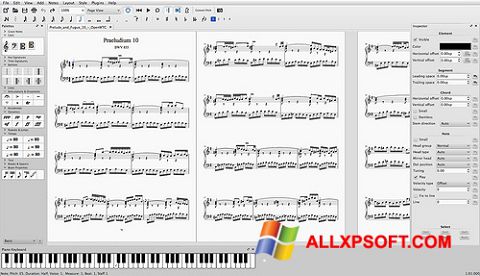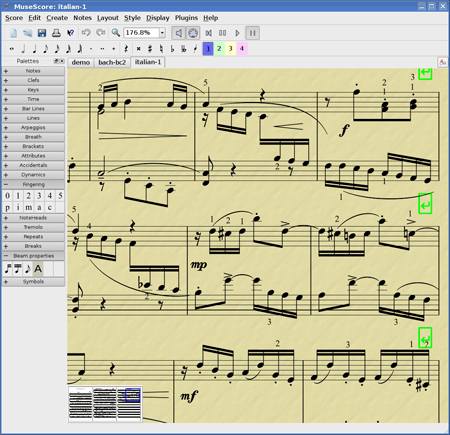music composition and notation
Musescore Free Download
Create, play back and print beautiful sheet music with free and easy to use music notation software MuseScore. For Windows, Mac and Linux. Create, play back and print beautiful sheet music with free and easy to use music notation software MuseScore. For Windows, Mac and Linux. MuseScore lets you notate and compose music easily with your keyboard, your mouse or a MIDI keyboard. You can print the beautifully engraved sheet music or save it as PDF or PNG.
Download from PortableApps.com
Version 3.6.2 for Windows, Multilingual
88MB download / 262MB installed
Antivirus Scan | Details
MuseScore Portable can run from a cloud folder, external drive, or local folder without installing into Windows. It's even better with the PortableApps.com Platform for easy installs and automatic updates.
- Support MuseScore development
- Support PortableApps.com's development and hosting

Description

Create, play back, and print sheet music for free. MuseScore is cross-platform, multi-lingual, open source music notation software. It features an easy to use WYSIWYG editor with audio score playback for results that look and sound beautiful. It supports unlimited staves with up to four voices each, dynamics, articulations, lyrics, chords, lead sheet notation, import/export of MIDI and MusicXML, export to PDF and WAV, plus online score sharing.
Support
For help with this app, please see the following:
- External: Publisher Documentation
- External: Publisher Support
- PortableApps.com Forum: Portable App Support
Download Details
Free Music Composition Site
- Publisher: MuseScore Team & PortableApps.com
- Date Updated: 2021-04-13
- Date Added: 2011-02-25
- System Requirements: Windows 7, 8, 10
- App License: Open Source (GPL)
- Source: MuseScore, PortableApps.com Launcher, PortableApps.com Installer
- MD5 Hash: b27d69d342e5705fcd282e97388de6b3
- SHA256 Hash: f6288feae230eed481b4cef1b943c6d1f686ce1a5193cb40973257a2f19e2d4a
And here it is imported into Denemo (1.0.5) and typeset by LilyPond (2.16), nothing here has been re-positioned by hand.
To get an idea of just how much additional hand positioning is involved in creating the MuseScore version, consider what happens when the piece is altered – a lot of the hand positioning has to be re-done. For exampe, here MuseScore (ver. 1.3) has transposed it up a fourth,
The first few bars look quite good, but looking through you can see that MuseScore requires you to drag many things into a nice-looking position, the hairpins clash, the text crashes the notes in several places, the penultimate bar is even unreadable.And here Denemo has done the same.
This is actually the same Denemo file – no changes have been made except to tell LilyPond to transpose the music. The hairpins, dynamics, ornaments etc are all moved by LilyPond to new positions without any further work. This is not magic, the bad typesetting of MuseScore is just the penalty you have to pay for typesetting while you input the music. With Denemo you just put in the music and edit it at will, without needing to move things around to make it look good.
 The downside is if you are doing some whacky-looking thing, with notes turned on their side and stuff drawn on top of other stuff, etc. then you will have a lot more work to do than using a drawing-based program.This also illustrates another advantage of Denemo over MuseScore – the same Denemo file can be used to print out both versions, and indeed a selection of parts all with a single command. So any correction made to the score needs only be made once and the Print All Layouts command invoked to print out all the score layouts you have created in the file.
The downside is if you are doing some whacky-looking thing, with notes turned on their side and stuff drawn on top of other stuff, etc. then you will have a lot more work to do than using a drawing-based program.This also illustrates another advantage of Denemo over MuseScore – the same Denemo file can be used to print out both versions, and indeed a selection of parts all with a single command. So any correction made to the score needs only be made once and the Print All Layouts command invoked to print out all the score layouts you have created in the file.Importing MusicXML
Example 1
This is something Musescore does better than Denemo – for example Musescore can import lyrics. Here is the example generated by Sibelius imported into Musescore. Musescore has spread the music over two pages, and some of the measures have stretched to fill a whole line:
See the Sibelius comparison page for how Denemo typesets this by default.
Example 2
Another example of how well Musescore does MusicXML import can be seen by re-importing the Reunion example into Musescore after exporting it as MusicXML:
Only the Ottava at the end has been missed, but the numerous crashes of the notation that Musescore’s default typesetting has generated does illustrate just how much hand adjusting of the music typesetting is required if you use Musescore rather than Denemo.
